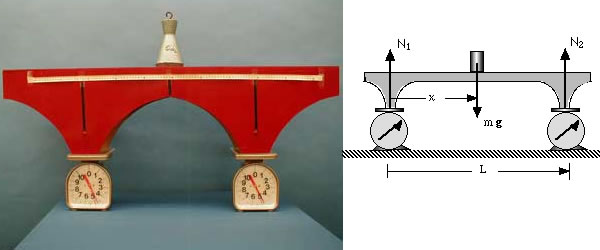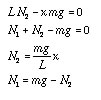Demos: 1J-14 Equilibrium of a Bridge

A long bridge is set on some scales and a weight is moved along the bridge to show how the force at each support changes with position of the weight.
With just the bridge sitting on the scales, the scales read equal amounts. This reading can be taken as zero. We have, taking torques about the left-hand support:
If the weight is placed in the center of the bridge, N1 = N2 = mg/2, as expected.

Directions: Set the bridge carefully on the scales. Be sure the scales are adjusted to read the same when the weight is not on it. (The bridge is symmetric about its center and should place equal weight on each scale.) Move the weight along the bridge and note how the scale readings change. The sum of the readings (within error) should remain constant.
Suggestions for Presentation: This is pretty straightforward. You might begin by discussing how the weight would change on bridge supports as a large vehicle passes over it.
Applications: A good application of this concept is the weighing of a large truck by placing a scale under a front wheel and then under a rear wheel (this can be done by inspectors on the side of the road, for example).
Last Updated: Nov 30, 2023 11:25 AM